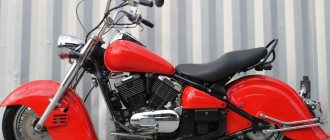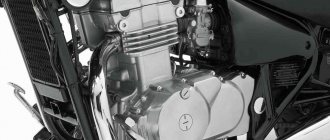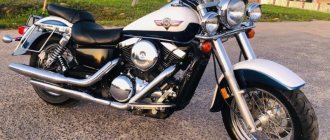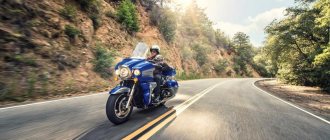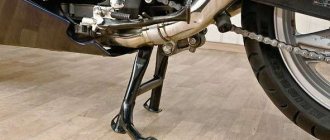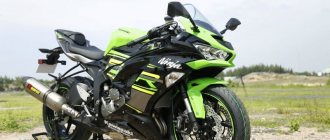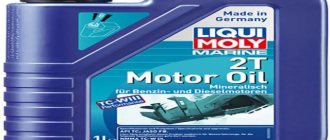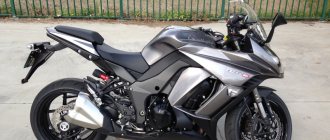This motorcycle can be called a modern classic. The alloy wheels give off some kind of sporting associations, and the colors seem to hint at his hot temperament. If you look at a motorcycle from a distance, it may even seem like a sports bike. However, at its core it is a classic cruiser.
The motorcycle is an ideological continuation of the Vulcan EN 500. Much has been improved and changed. The bike also has a second name – Kawasaki EN 650 Vulcan, which indicates its close relationship with the entire Vulcan series and continuity with the 500th model.
Specifications
In terms of its technical data, the motorcycle surpasses many bikes in its class. The Vulcan S claims to be a moderately sporty classic due to its dynamism and relative power. The filling also provides maneuverability at fairly high speeds, which will certainly be appreciated by those who crave a fast and comfortable ride.
The main idea of the famous concern was a motorcycle with a brutal exterior, similar to a power cruiser, but its filling was typical for the class. The motorcycle will be familiar to experienced users of such bikes, and will not be too difficult to control for a beginner.
Salute Bikepost!
First 1000 km on Kawasaki Vulcan S (2016) after Kawasaki W650 (2003).
A short note after the run-in, instead of “Training deja vu #...”.
I’m happy to report that I DID NOT FIND any terrible motorcycle accidents recorded on video this week! HOORAY! (Photos are from telephone) This is my second motorcycle. The first one was purchased very quickly and the main factor was the WOW effect! (In the first photo on the left is a Kawasaki W650). With Harley I also had the same effect, but the second time I already slowed myself down. I went for a test drive and was completely disappointed. I chose a number of models and, after weighing all the pros and cons, purchased a Kawasaki Vulcan S. Let's go:
- It turns out that none of my non-motorcyclist friends knows what a cruiser is)) Chopper is immediately clear to everyone.
- Removing and installing the seat is a pain. I got used to the classics - I opened the lock with the key and that’s it. Immediately: remove the side trim, take out the key under it, use it to unscrew the screw, remove the seat. Install it in the reverse order, and by touch, install the side trim at the same time: with the pin in the hole, two guides in the slide and the lock tongue in the recess. Now I understand why cruisers don't take advantage of the space under the seat.
- You go over all road bumps more slowly. You can contrive and stand up on the footrests, but this will only make it worse - you will get a significant kick in the ass with the seat. This was expected and did not come as a surprise.
- The reverse side of the previous point is an insane thrill for the knees in the long run. If you want, straighten one leg and put it on the footrest, or if you want, both. I screwed the rings on the Ring Road for break-in - 500 km at a time is not a problem. If it weren’t for being chilled to the bone at t +7 (data from the info board above the Ring Road), I would have driven it in a day.
- Sixth gear is very good. 4000 on the tachometer and the speed is about 100 km/h, 6000 - 130 and the engine does not strain.
- 130 km/h is not a comfortable speed due to air pressure. I don’t know what makes such a difference in aerodynamics compared to the classics, but on the latter I bent over the steering wheel and everything was ok. No matter how you bend over on the neo-chopper, the helmet tries to press your nose and chin into the depths of your skull)). Do not offer wind deflectors! Only hardcore! Hardly driveable only! )))
- The engine gives excellent dynamics.
- The long wheelbase doesn’t even hint at the front wheel coming off, but just a little bit – the rear wheel washes.
- The box clicks easily and naturally. The first with a slight knock and a slightly noticeable jerk.
- Working zone from 4000 to 9000 rpm. If you were a little lazy and didn’t put in a lower gear when accelerating/overtaking, you end up with clanging valves and shaking mirrors. Chu! I pressed the clutch, it went away, but the dynamics are not the same, it’s still better to switch to a lower gear. If you don’t forget about this, everything is great.
- I learned what easy handling is. I don’t understand why the W650 was so hard to corner, maybe because of the old school Firestone Deluxe tires. The Vulcan S makes it easy and effortless. At some point it starts to seem like enough is enough, this is not a sportbike. In addition to the type of tire, the size of the front disc apparently also affects it: 19 versus 18. Direct detour around the potholes is so easy that, having become impudent, I started doing it with one hand, I need to stop. )) Now I understand why all testers praise the handling of the Vulcan S so much.
- Data reflecting the estimated distance to the reserve in the tank shows almost instantaneous fuel consumption. This is convenient for long-distance travel and very confusing in the city. When driving from traffic light to traffic light, it is better not to look at these numbers at all; a long scale of divisions of the fuel level in the tank is quite sufficient. For example, with constant movement, 100-110 km/h shows 350-400 km to the reserve, but if you turn it up - 150-180 km to the reserve.
- The sound of the standard exhaust in place and in traffic jams is absolutely nothing, there is simply no sound. It doesn't exist at speed either. But wow, how I like to suddenly add gas in 5th or 6th gear. From 4000 rpm, a rich, bass rumble bursts out of the exhaust system up to 8000, then it fades away. If I play something like Two Brothers or Arrow, it will definitely only be with a DB killer. For long-distance direct flows, my firm answer is NO!
- You have to get out of the habit of moving your feet in traffic jams at near-zero speed. From the classic height it is very comfortable (to move your feet), but the chopper low landing turns you into a praying mantis)))
- When braking, the body weight is not entirely on the knees squeezing the tank, but is also distributed over the feet resting on the footpegs.
. . Bottom line: here I can only thank Kawasaki for a bold attempt to combine the incompatible and cram in the inconvenient, I got everything that I was missing on the W650: Ruff dynamics + comfortable, relaxed Vulcan seating = my knees no longer go numb, and even during acceleration At 650cc, sometimes you have to grab the steering wheel tighter. I am delighted!
Have fun and have a great season!
Engine
The engine of the car is characteristic - it has two cylinders and four strokes, and its type is in-line. Why characteristic? Kawasaki in the Vulcan series has long used mainly a V-shaped version, but it was decided that this kind of engine would be more suitable.
This motor provides great capabilities. Just look at the acceleration alone: the bike can reach a speed of 100 kilometers per hour in just 4.2 seconds. Those who are familiar with the series will understand that this is a very high figure for Vulcan. In addition, the motorcycle is superior to bikes from many other brands in this regard.
The maximum speed of the car is 175 kilometers per hour. This is a good indicator for a cruiser, and allows us to talk about it as a fast motorcycle, especially taking into account its acceleration. Such successes of the model are explained by serious indicators of power and torque.
At its peak, the torque of Vulcan C is 63 newton meters. This figure is achieved at 6600 rpm. In terms of power at maximum level, the engine reaches 61 horsepower at 7500 rpm. The engine displacement is 649 cubic centimeters. These characteristics allow the motorcycle to remain one of the fastest cruisers in its weight category.
As a motorcycle for everyday riding
One of the selling points of the Vulcan S is its Ergo Fit system and the ability to tailor it to the rider's preferences thanks to a combination of 2 handlebar settings, three seat settings (short, medium, extended) and three footpeg positions (rear, mid, front). Thanks to this, you can choose the Vulcan S as a motorcycle for everyday riding. As for the CTX700N, it has a wide seat with plenty of padding, making it a comfortable ride for the first 100 miles or so. However, on longer trips the padding becomes soft and pressure begins to put on the tailbone. My friend also noted that after a long ride in the Honda seat at high speed, he felt fatigue in his hips and shoulders.
The Vulcan S has a relaxed, comfortable cockpit that allows you to ride all day without any problems. The seat is small but distributes weight well and the mid-position footpegs are perfect for drivers of my height (183cm)
While the Vulcan S excels in ergonomics, it also outperforms its rival in braking. Thanks to the 300 mm front brake disc and 2-piston Nissin calipers, braking power is strong, even very strong. Braking feels good when you press the lever, although initial braking is somewhat mild. The single 250mm rear brake disc is fitted with a single-piston Nissin caliper, but benefits from Bosch 9.1M ABS. The Vulcan S's anti-lock braking system isn't overly intrusive, nor is it overly intrusive.
The CTX700N has a 320mm disc and 2-piston caliper at the front, and a 240mm disc at the rear, which also features a single-piston caliper. While the brake packages on both bikes are decent, it's worth noting that the combination on the Vulcan S is more powerful. But again, it's worth saying that I tested the Vulcan S with the ABS package, which definitely helps in this process. Both bikes are available with or without ABS, however, adding ABS to the base model CTX700N costs slightly more than adding it to the base model Vulcan S. Although, to my knowledge, Honda only offers ABS on the CTX700N with DTC. (Dual-Clutch Transmission), so by purchasing ABS you have to pay more, but in addition to the anti-lock braking system itself you will get an automatic transmission.
Dimensions and weight
The dimensions of the bike are average. Its length reaches 2310 millimeters, its height is 1100 millimeters, and its width is 880 millimeters. Yes, you can’t call it large, but you can’t call it small either. The height of the motorcycle at the saddle is 705 millimeters. Wheelbase dimensions are 1575 millimeters.
The weight of the motorcycle is very moderate: the curb weight is 225 kilograms.
Chassis and brakes
The tubular frame of this bike is made of high quality steel. Its design perfectly matches the character of the motorcycle and its purpose. Relief outlines emphasize the energy and speed of the car.
The rear suspension is a Uni-trak pendulum suspension equipped with a monoshock absorber. The travel of this suspension is 80 millimeters. The front suspension is a 41 mm telescopic fork with a travel of 140 mm. These suspensions maximally correspond to the tasks that the concern has set for the motorcycle.
The wheels are stylish alloy wheels that harmonize with the classic look of the bike. The steering wheel provides plenty of control over the steel monster. The rear brakes are a single 250mm disc with a single-piston caliper, while the front brakes are a 300mm disc and a two-piston caliper.
Appearance of cruisers
The main factor in the cruiser niche is appearance. Of course, the styling can be arbitrary, but the way the bike looks is the first thing that plays on the emotional chords of potential customers, those special guys who love cruisers. Honda motorcycles have a lot of plastic installed on them, from the body to the fuel tank covers. Its pipe is large and has a somewhat vague appearance, although it attracts quite a lot of attention. The CTX700N features a large, easy-to-see digital display mounted in a housing above the headlight. The large speedometer numbers are easy to read. There is a tachometer on top and a fuel gauge on the right.
With less elaborate bodywork, the Vulcan S leaves much less to the imagination, as much of the perimeter architecture of its tubular steel frame and Parallel Twin engine is visible from the outside. The chunky rear fender looks attractive, but I didn't like the bulky plastic housing for the taillight, turn signals and license plate. The Vulcan S's display is smaller. Below the round digital speedometer is the fuel gauge. The tachometer is a special device here. Its needle moves quickly across the dial as the driver revs his Vulcan S, which can be higher than his rival's. I looked at people's reactions from the outside and noticed that the Vulcan S was liked by more casual passers-by than the Honda.

